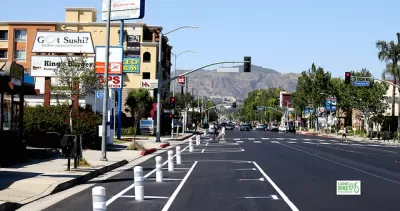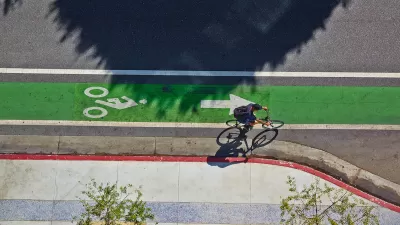The group, Fix The City, sued the city on September 9 on its visionary plan that emphasizes transit, biking, and walking, claiming the traffic lane reductions will create more air pollution, imperil public safety, and add to traffic congestion.

David Zahniser of the Los Angeles Times writes that Fix The City claims that the bold plan to reshape the city's streetscape, with its road diets, bus-only lanes, and protected bike lanes will:
- "Lead to increased tailpipe emissions as drivers confront fewer car lanes and greater traffic congestion.
- "Threaten emergency responders struggling to make their way through traffic."
- Increase congestion for the public, the vast majority of whom will continue to drive their own vehicles and be delayed by the the increased congestion caused by the plan.
- "Nearly 36% of major street segments would be heavily congested in 2035, up from 18% currently, the report said.
- "The same analysis found that if the mobility plan were not approved, the number would reach only 22% in 2035."
The group is suing under the California Environmental Quality Act (CEQA), claiming the city's environmental review and public outreach is insufficient, and that it doesn't abide by the city General Plan. Click here [PDF] to view petition.
Fix The City and other groups that have opposed city land use decisions that increased density have won several cases lately, according to Zahniser:
- "In 2013, they were part of a coalition that succeeded in striking down the Hollywood Community Plan, which sought to allow taller, denser residential towers near transit stops. New environmental documents are being prepared on that plan.
- "In April, a judge overturned the city's approval of the Millennium Project, a pair of skyscrapers planned in Hollywood, saying traffic circulation had not been properly examined.
- "And on Wednesday, a three-judge panel upheld a decision invalidating permits for the 299-unit Sunset and Gordon apartment tower, also in Hollywood."
Fix the City's lawsuit amounts to a "battle for the future of Los Angeles," writes Dennis Romero of L.A. Weekly. "One month ago the L.A. City Council voted to adopt a visionary plan that would guide the transformation of the city from a car-crazed metropolis to one much more dependent on bikes, trains, buses and your feet."
The plan is the new blueprint for L.A.'s so-called Third Wave of growth in which the city is repopulating its core and focusing on more vertical, dense, public transportation–friendly housing and retail
Romero adds that the group "seeks to halt implementation of the plan until it's made consistent with the General Plan and its requirements for public feedback."
FULL STORY: Lawsuit says new L.A. streets plan creates more air pollution, not less

Planetizen Federal Action Tracker
A weekly monitor of how Trump’s orders and actions are impacting planners and planning in America.

Maui's Vacation Rental Debate Turns Ugly
Verbal attacks, misinformation campaigns and fistfights plague a high-stakes debate to convert thousands of vacation rentals into long-term housing.

San Francisco Suspends Traffic Calming Amidst Record Deaths
Citing “a challenging fiscal landscape,” the city will cease the program on the heels of 42 traffic deaths, including 24 pedestrians.

Amtrak Rolls Out New Orleans to Alabama “Mardi Gras” Train
The new service will operate morning and evening departures between Mobile and New Orleans.

The Subversive Car-Free Guide to Trump's Great American Road Trip
Car-free ways to access Chicagoland’s best tourist attractions.

San Antonio and Austin are Fusing Into one Massive Megaregion
The region spanning the two central Texas cities is growing fast, posing challenges for local infrastructure and water supplies.
Urban Design for Planners 1: Software Tools
This six-course series explores essential urban design concepts using open source software and equips planners with the tools they need to participate fully in the urban design process.
Planning for Universal Design
Learn the tools for implementing Universal Design in planning regulations.
Heyer Gruel & Associates PA
JM Goldson LLC
Custer County Colorado
City of Camden Redevelopment Agency
City of Astoria
Transportation Research & Education Center (TREC) at Portland State University
Jefferson Parish Government
Camden Redevelopment Agency
City of Claremont




























